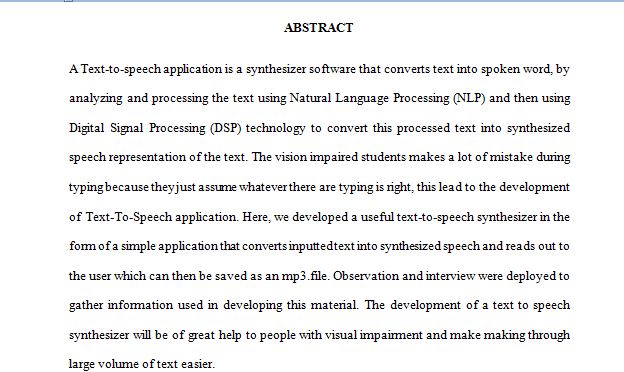ABSTRACT
A Text-to-speech application is a synthesizer software that converts text into spoken word, by analyzing and processing the text using Natural Language Processing (NLP) and then using Digital Signal Processing (DSP) technology to convert this processed text into synthesized speech representation of the text. The vision impaired students makes a lot of mistake during typing because they just assume whatever there are typing is right, this lead to the development of Text-To-Speech application. Here, we developed a useful text-to-speech synthesizer in the form of a simple application that converts inputted text into synthesized speech and reads out to the user which can then be saved as an mp3.file. Observation and interview were deployed to gather information used in developing this material. The development of a text to speech synthesizer will be of great help to people with visual impairment and make making through large volume of text easier.
TABLE OF CONTENTS
Title page – – – – – – – – – i
Certification – – – – – – – – – ii
Dedication – – – – – – – – – iii
Acknowledgement – – – – – – – – iv
Abstract – – – – – – – – – v
Table of content – – – – – – – – vi
CHAPTER ONE: Introduction
1.1 Introduction – – – – – – – – 1
1.2 Background of study – – – – – – 2
1.3 Statement of problem – – – – – – 3
1.4 Objective of study – – – – – – – 3
1.5 Scope of study – – – – – – – 4
1.6 Significant of study – – – – – – 4
1.7 Limitation of study – – – – – – 4
1.8 Definition of terms – – – – – – – 5
CHAPTER TWO: Literature review
2.1 Introduction – – – – – – – – 6
2.2 Different type of data – – – – – – 6
2.2 Classes of data types- – – – – – – 8
2.2.2 Composite Types – – – – – – 10
2.2.2 Other Types – – – – – – – 12
2.3 Data conversion – – – – – – – 13
2.4 Text-to-speech application – – – – – 14
2.5 Different challenges in individual (disability) – – 17
2.6 Technology to overcome different challenges – – 19
2.7 Over goals of empowering persons with disabilities through
Technology – – – – – – – – 21
2.8 Empowerment of the target group – – – – 23
2.9 The benefits of ICT in e-learning and improving capabilities
Of students with disabilities – – – – – 23
2.10 Technology for persons with disabilities – – – 25
2.10.1 E-learning and education of students with disabilities – 26
2.10.2 Persons with disabilities moving from isolation to integration- 27
2.11 ICT providing computer accessibility for persons with
disabilities – – – – – – – – 30
CHAPTER THREE: System Analysis Design
3.1 Introduction – – – – – – – – 31
3.2 System analysis – – – – – – – 31
3.2.1 Detailed definition of the problem – – – 31
3.2.3 Feasibility study – – – – – – 32
3.3 Method of collecting data – – – – – 32
3.3.1 Interview – – – – – – – – 32
3.3.2 Observation – – – – – – – 33
3.3.3 Review of procedure manual or existing system/procedure- 33
3.3.4 Evaluation of forms – – – – – – 33
3.4 Problem of the existing system – – – – 34
3.5 User preparation – – – – – – – 34
3.6 Data preparation – – – – – – – 35
3.6 Objective of the new design – – – – – 35
3.8 Design of the new system – – – – – 36
3.9 Program structure – – – – – – – 36
3.9.1 Modularity – – – – – – – 36
3.9.2 Top-down program design – – – – 37
3.9.3 System flowchart – – – – – – 37
3.9.4 Program flow chart – – – – – – 37
3.10 File Maintenance module – – – – – – 37
3.11 main menu specifications – – – – – – 38
3.11.1 Output specification – – – – – – 38
3.11.2 Input specification – – – – – – 38
3.11.3 File/database specifications – – – – 38
CHAPTER FOUR: System Implementation and Design
4.1 Introduction – – – – – – – – 40
4.2 Justification of the programming language – – 40
4.3 System control – – – – – – – 41
4.4 System requirements – – – – – – 41
4.4.1 Hardware requirements – – – – – 42
4.4.2 Software requirements – – – – – 42
4.4.3 People – – – – – – – – 43
4.5 Implementation details – – – – – – 43
4.5.1 Coding – – – – – – – – 43
4.5.2 System testing – – – – – – – 43
4.5.3 Training and re-training of staff – – – 44
4.5.4 File Conversion – – – – – – – 45
4.5.5 Changeover procedure – – – – – 45
4.5.6 User manuals – – – – – – – 46
4.5.7 Maintenance details – – – – – – 47
CHAPTER Five: Summary, Conclusion and Recommendation
5.1 Summary – – – – – – – – 48
5.2 Conclusion – – – – – – – – 48
5.3 Recommendation – – – – – – – 49
Reference – – – – – – – – 50
